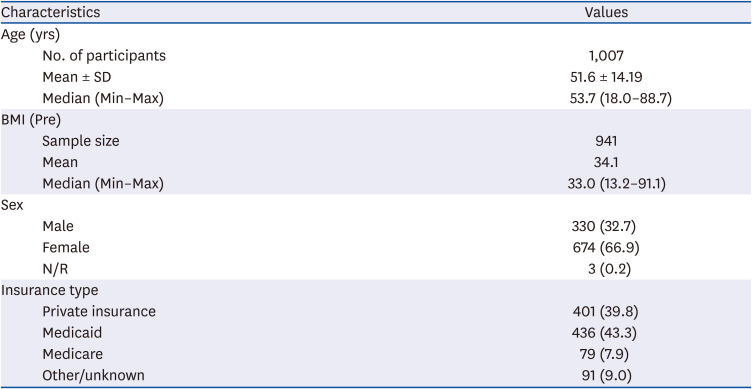1. Cockerham WC, Hamby BW, Oates GR. The social determinants of chronic disease. Am J Prev Med. 2017; 52:S5–12. PMID:
27989293.

2. Briggs Early K, Stanley K. Position of the Academy of Nutrition and Dietetics: the role of medical nutrition therapy and registered dietitian nutritionists in the prevention and treatment of prediabetes and type 2 diabetes. J Acad Nutr Diet. 2018; 118:343–353. PMID:
29389511.

3. Larson E. Disease management, registered dietitians and medical nutrition therapy. J Am Diet Assoc. 2002; 102:190–191. PMID:
11846110.

4. Academy of Nutrition and Dietetics, Evidence Analysis Library. Medical nutrition therapy [Internet]. Chicago (IL): Academy of Nutrition and Dietetics;2020. cited 2020 Oct 12. Available from:
https://www.andeal.org/topic.cfm?menu=5284.
6. Peregrin T. Social determinants of health: enhancing health equity. J Acad Nutr Diet. 2021; 121:1175–1178.

7. Diabetes Prevention Program (DPP) Research Group. The Diabetes Prevention Program (DPP): description of lifestyle intervention. Diabetes Care. 2002; 25:2165–2171. PMID:
12453955.
8. Diabetes Prevention Program Research Group. Knowler WC, Fowler SE, Hamman RF, Christophi CA, Hoffman HJ, Brenneman AT, Brown-Friday JO, Goldberg R, Venditti E, Nathan DM. 10-year follow-up of diabetes incidence and weight loss in the Diabetes Prevention Program Outcomes Study. Lancet. 2009; 374:1677–1686. PMID:
19878986.
9. Ryan DH, Espeland MA, Foster GD, Haffner SM, Hubbard VS, Johnson KC, Kahn SE, Knowler WC, Yanovski SZ. Look AHEAD Research Group. Look AHEAD (Action for Health in Diabetes): design and methods for a clinical trial of weight loss for the prevention of cardiovascular disease in type 2 diabetes. Control Clin Trials. 2003; 24:610–628. PMID:
14500058.
10. Zazpe I, Sanchez-Tainta A, Estruch R, Lamuela-Raventos RM, Schröder H, Salas-Salvado J, Corella D, Fiol M, Gomez-Gracia E, Aros F, et al. A large randomized individual and group intervention conducted by registered dietitians increased adherence to Mediterranean-type diets: the PREDIMED study. J Am Diet Assoc. 2008; 108:1134–1144. PMID:
18589019.

11. Raynor HA, Davidson PG, Burns H, Nadelson MD, Mesznik S, Uhley V, Moloney L. Medical nutrition therapy and weight loss questions for the evidence analysis library prevention of type 2 diabetes project: systematic reviews. J Acad Nutr Diet. 2017; 117:1578–1611. PMID:
28958344.

12. Wanik JA, Marcus AF, Radler DR, Byham-Gray LD, Touger-Decker R. Physical activity level is associated with maintaining anthropometric improvements among participants in a worksite wellness program. Am J Lifestyle Med. 2016; 11:489–500. PMID:
30202375.

13. Irving SM, Njai RS, Siegel PZ. Food insecurity and self-reported hypertension among Hispanic, black, and white adults in 12 states, Behavioral Risk Factor Surveillance System, 2009. Prev Chronic Dis. 2014; 11:E161. PMID:
25232748.

14. Seligman HK, Bindman AB, Vittinghoff E, Kanaya AM, Kushel MB. Food insecurity is associated with diabetes mellitus: results from the National Health Examination and Nutrition Examination Survey (NHANES) 1999–2002. J Gen Intern Med. 2007; 22:1018–1023. PMID:
17436030.

15. Ippolito MM, Lyles CR, Prendergast K, Marshall MB, Waxman E, Seligman HK. Food insecurity and diabetes self-management among food pantry clients. Public Health Nutr. 2017; 20:183–189. PMID:
27406399.

16. Seligman HK, Jacobs EA, López A, Tschann J, Fernandez A. Food insecurity and glycemic control among low-income patients with type 2 diabetes. Diabetes Care. 2012; 35:233–238. PMID:
22210570.

17. Berkowitz SA, Basu S, Meigs JB, Seligman HK. Food insecurity and health care expenditures in the United States, 2011–2013. Health Serv Res. 2018; 53:1600–1620. PMID:
28608473.

19. Holben DH, Marshall MB. Position of the Academy of Nutrition and Dietetics: food insecurity in the United States. J Acad Nutr Diet. 2017; 117:1991–2002. PMID:
29173349.

20. Mitchell LJ, Ball LE, Ross LJ, Barnes KA, Williams LT. Effectiveness of dietetic consultations in primary health care: a systematic review of randomized controlled trials. J Acad Nutr Diet. 2017; 117:1941–1962. PMID:
28826840.

21. Hartman TJ, Haardörfer R, Whitaker LL, Addison A, Zlotorzynska M, Gazmararian JA, Kegler MC. Dietary and behavioral factors associated with diet quality among low-income overweight and obese African American women. J Am Coll Nutr. 2015; 34:416–424. PMID:
25910081.

22. Booth SL, Sallis JF, Ritenbaugh C, Hill JO, Birch LL, Frank LD, Glanz K, Himmelgreen DA, Mudd M, Popkin BM, et al. Environmental and societal factors affect food choice and physical activity: rationale, influences, and leverage points. Nutr Rev. 2001; 59:S21–39. PMID:
11330630.

23. Emery CF, Olson KL, Lee VS, Habash DL, Nasar JL, Bodine A. Home environment and psychosocial predictors of obesity status among community-residing men and women. Int J Obes. 2015; 39:1401–1407.

24. Phelan S, Liu T, Gorin A, Lowe M, Hogan J, Fava J, Wing RR. What distinguishes weight-loss maintainers from the treatment-seeking obese? Analysis of environmental, behavioral, and psychosocial variables in diverse populations. Ann Behav Med. 2009; 38:94–104. PMID:
19847584.

25. Gorin AA, Phelan S, Raynor H, Wing RR. Home food and exercise environments of normal-weight and overweight adults. Am J Health Behav. 2011; 35:618–626. PMID:
22040622.

26. Gorin AA, Raynor HA, Fava J, Maguire K, Robichaud E, Trautvetter J, Crane M, Wing RR. Randomized controlled trial of a comprehensive home environment-focused weight-loss program for adults. Health Psychol. 2013; 32:128–137. PMID:
22309885.

28. Hager ER, Quigg AM, Black MM, Coleman SM, Heeren T, Rose-Jacobs R, Cook JT, Ettinger de Cuba SA, Casey PH, Chilton M, et al. Development and validity of a 2-item screen to identify families at risk for food insecurity. Pediatrics. 2010; 126:e26–32. PMID:
20595453.

30. Wing RR, Phelan S. Long-term weight loss maintenance. Am J Clin Nutr. 2005; 82:222S–225S. PMID:
16002825.

31. Dhurandhar NV, Schoeller D, Brown AW, Heymsfield SB, Thomas D, Sørensen TI, Speakman JR, Jeansonne M, Allison DB. Energy Balance Measurement Working Group. Energy balance measurement: when something is not better than nothing. Int J Obes (Lond). 2015; 39:1109–1113. PMID:
25394308.

32. Knoblock-Hahn A, Medrow L, Hand RK, Murphy Gutuskey L, Brown K. The RD Parent Empowerment and Supplemental Food Pilot Program for improved food security, nutrition, and family behaviors. J Acad Nutr Diet. 2017; 117:1114–1119. PMID:
27825794.

33. Russell M. Food security for everyone: an academy priority. J Acad Nutr Diet. 2019; 119:191. PMID:
30686379.







 PDF
PDF Citation
Citation Print
Print





 XML Download
XML Download